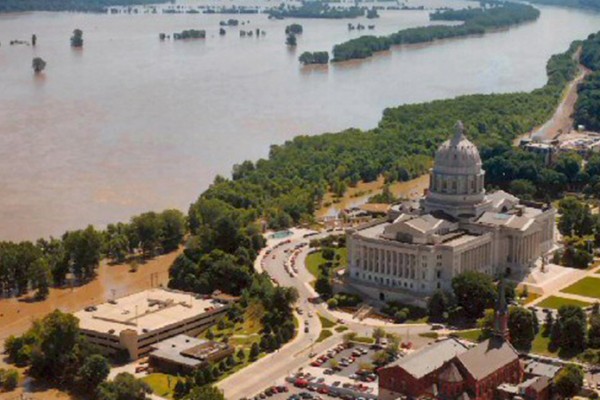Blake Thornton: No. 1 standup paddleboarder
Washington University in St. Louis mathematician Blake Thornton, PhD, came in first in the paddleboard division of the MR340, an endurance race on the Missouri River. Before signing up for next year’s race, you might want to read this article as well as watch the video.
Major Midwest flood risk underestimated by as much as 5 feet, study finds
As floodwaters surge along major rivers in the midwestern United States, a new study from Washington University in St. Louis suggests federal agencies are underestimating historic 100-year flood levels on these rivers by as much as five feet, a miscalculation that has serious implications for future flood risks, flood insurance, and business development in an expanding floodplain.
Lewis and Clark data show narrower, more flood-prone River
Robert Criss, Ph.D., professor of earth and planetary sciences in Arts & Sciences, has analyzed data from the Lewis and Clark expedition and says it shows that the Missouri River today is but a shadow of what it was two hundred years ago, narrower and more prone to serious flooding.A geologist at Washington University in St. Louis and his collaborator at Oxford University have interpreted data that Lewis and Clark collected during their famous expedition and found that the Missouri River has markedly narrowed and its water levels have become more variable over the past two hundred years. This narrowing, or channeling, created by wing dikes and levees constructed mainly in the 20th century, has put the Missouri River at an increased risk of more damaging floods, the authors say. They blame the fact that the river cannot spread out as it did naturally at the turn of the 19th century, thus forcing water levels higher. More…
Lewis and Clark data show a different Missouri River
WUSTL scientists say the present-day Missouri River is narrower and more prone to flooding because of extensive damming of the river.The oldest data available on the Missouri River – from the logs of Lewis and Clark – show that water flow on the river today is far more variable than it was 200 years ago. The data also show that the river is some 220 yards narrower at St. Charles, Mo., today at 500 yards across than in 1804 when it spread out some 720 yards.
Sustainable management of big rivers is topic of Earth Day forum, April 22
Photo courtesy U.S. Army Corps of EngineersBarge traffic makes its way through a lock on the Upper Mississippi.”Our Rivers: A Sustainable Resource?” is the focus of a public education forum that four Washington University faculty will lead as part of a community-wide symposium being held in conjunction with the 5th annual St. Louis Earth Day Celebration, April 22-23. The sustainable rivers program will be held April 22 from 10:30 a.m. to 5 p.m. and will feature Washington University faculty Charles Buescher, professor of environmental engineering, Robert Criss, Ph.D., professor of earth and planetary sciences in Arts & Sciences and William Lowry, Ph.D., professor of political science in Arts & Sciences. The colloquium will provide a background history of the rivers in our region and their various uses in transportation, agriculture, power production, recreation and public water supply.

